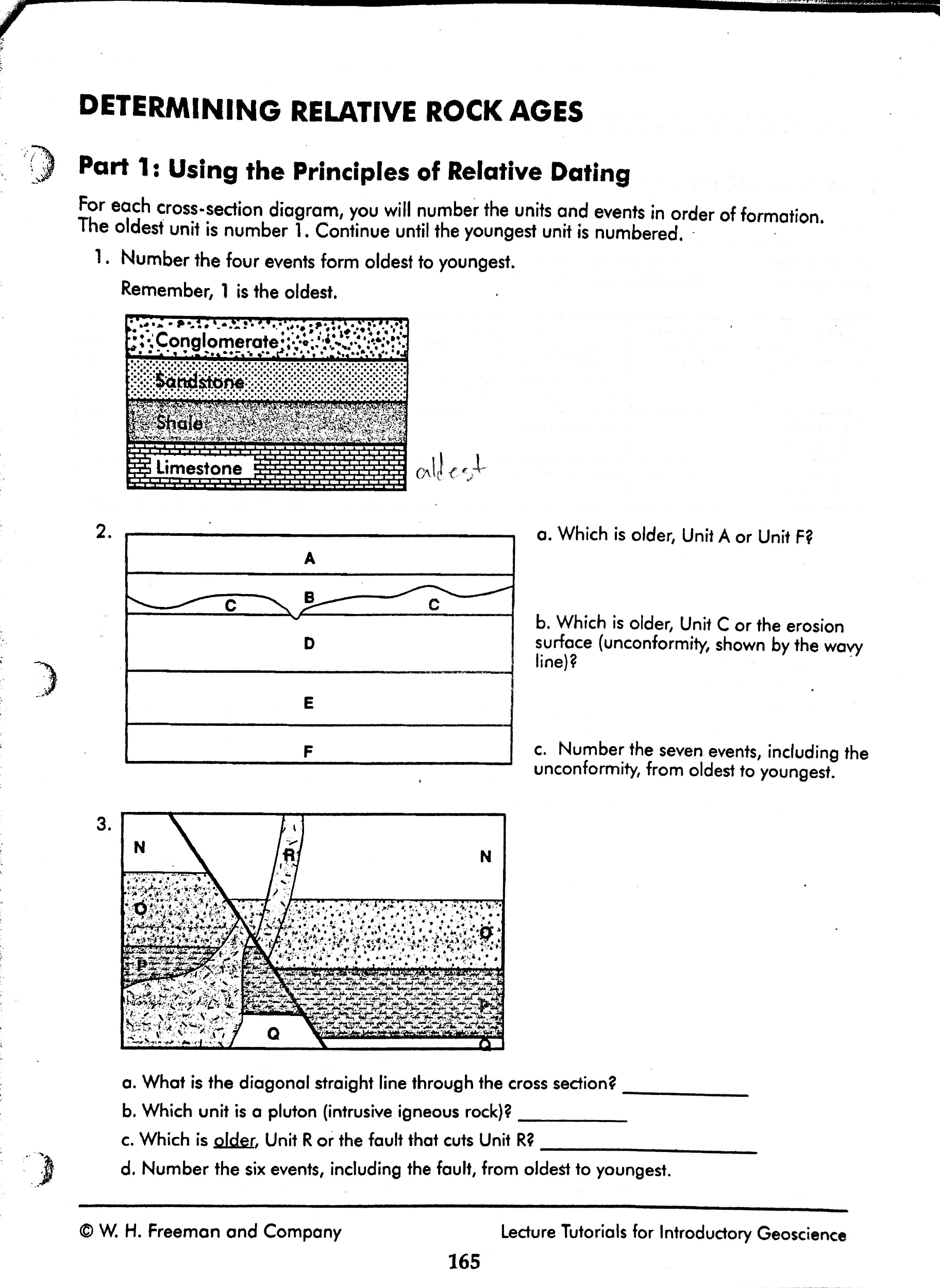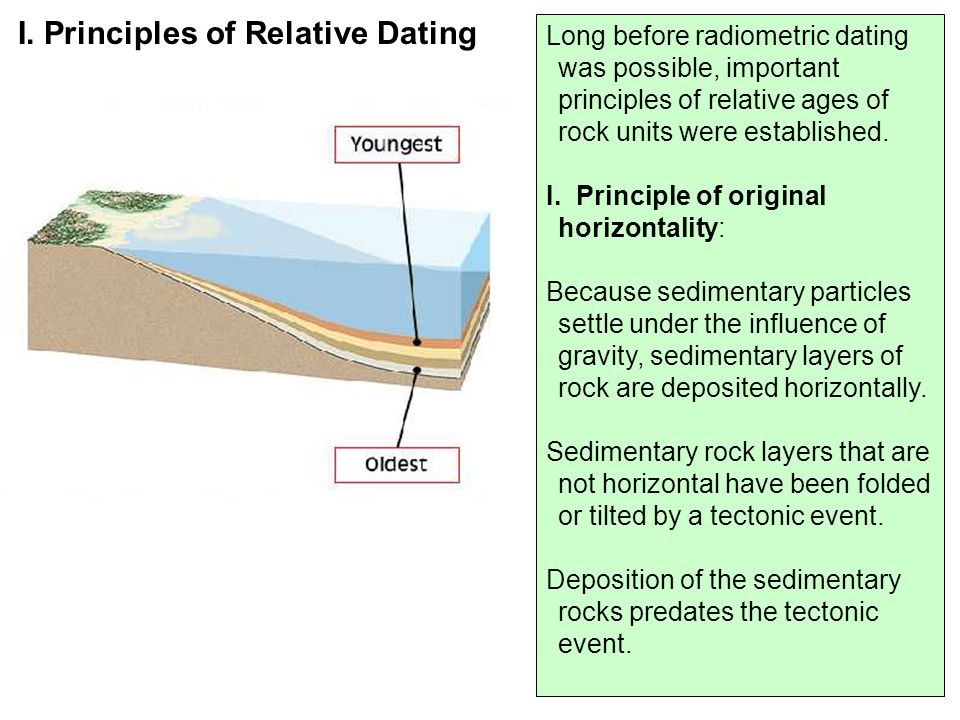This rule is called the Law of Superposition. Again, it's pretty obvious if you think about it. Say you have a layer of mud accumulating at the bottom of a lake. Then the lake dries up, and a forest grows in. More sediment accumulates from the leaf litter and waste of the forest, until you have a second layer.

The forest layer is younger than the mud layer, right? And, the mud layer is older than the forest layer. When scientists look at sedimentary rock strata, they essentially see a timeline stretching backwards through history. The highest layers tell them what happened more recently, and the lowest layers tell them what happened longer ago. How do we use the Law of Superposition to establish relative dates? Let's look at these rock strata here:. We have five layers total. Let's say we find out, through numerical dating, that the rock layer shown above is 70 million years old.
We're not so sure about the next layer down, but the one below it is million years old. Can we tell how old this middle layer is? Not exactly, but we do know that it's somewhere between 70 and million years old. Geologists use this type of method all the time to establish relative ages of rocks.
Geology Online Subchapter
What could a geologist say about that section of rock? Following the Principle of Original Horizontality, he could say that whatever forces caused the deformation, like an earthquake, must have occurred after the formation of all the rock strata. Since we assume all the layers were originally horizontal, then anything that made them not horizontal had to have happened after the fact.
We follow this same idea, with a few variations, when we talk about cross-cutting relationships in rock. Let's say, in this set of rock strata, that we found a single intrusion of igneous rock punching through the sedimentary layers. We could assume that this igneous intrusion must have happened after the formation of the strata. If it had happened before the layers had formed, then we wouldn't see it punching through all the layers; we would only see it going through the layers that had existed at the time that it happened.
Relative dating
The newer layers would have formed a cap overtop. The Principle of Cross-Cutting Relationships states that rock formations that cut across other rocks must be younger than the rocks that they cut across. The same idea applies to fault lines that slide rock layers apart from each other; a fault that cuts across a set of strata must have occurred after the formation of that set.
Geologists find the cross-cutting principle especially useful for establishing the relative ages of faults and igneous intrusions in sedimentary rocks. Sometimes, geologists find strange things inside the strata, like chunks of metamorphic or igneous rock. These items are called inclusions - foreign bodies of rock or mineral enclosed within another rock.
Because the sedimentary rock had to have formed around the object for it to be encased within the layers, geologists can establish relative dates between the inclusions and the surrounding rock.
The Grand Canyon and Relative Dating
Inclusions are always older than the sedimentary rock within which they are found. Other times, geologists discover patterns in rock layers that give them confusing information. There may be a layer missing in the strata, or a set of sedimentary rock on top of metamorphic rock. These interfaces between discontinuous layers of rock are called unconformities.
They complicate the task of relative dating, because they don't give an accurate picture of what happened in geologic history. For example, say we have a layer missing from the rock strata. That layer may have eroded away before the next layer was built upon the exposed surface. So, we'll never know what type of rock used to be there or what fossils it may have held.
- dating ideas in san francisco ca.
- ;
- .
- dating theme undertale;
One famous example of an unconformity is the Great Unconformity of the Grand Canyon. It clearly shows the interface between two types of rock: The sandstones lie horizontally, just as they did when they were originally laid down. But, the shales are all deformed and folded up. The tops of their folds are completely gone where the sandstones have replaced them. What can we make of this giant unconformity? Can we establish any relative ages between the rock strata or the cause of their formations? Well, following the Principle of Cross-Cutting Relationships, we can tell that whatever deformed the shales - probably an earthquake - must have occurred before any of the upper sandstones were deposited.
In fact, we can put together a timeline. The shales were deposited first, in a horizontal position, and then there was an earthquake that made them all fold up. Then, the tops were eroded off until the rock was basically flat, and then the sandstones were deposited on top of everything else. With only a few geologic principles, we've established the relative dates of all the phenomena we see in the Great Unconformity. Geologists establish the relative ages of rocks mostly through their understanding of stratigraphic succession.
The Principle of Original Horizontality states that all rock layers were originally horizontal. The Law of Superposition states that younger strata lie on top of older strata. The Principle of Cross-Cutting Relationships states that intrusions and faults that cut across rock are necessarily younger than that rock. Inclusions , or foreign bodies, found inside rock are necessarily older than that rock.
Description
And, unconformities show a discontinuity in the strata, which can only be understood by following the principles of stratigraphy. Geologists utilize all of these laws and principles to establish the relative ages of rocks and the relationships between events that occurred throughout geologic time. To unlock this lesson you must be a Study. Did you know… We have over college courses that prepare you to earn credit by exam that is accepted by over 1, colleges and universities.
You can test out of the first two years of college and save thousands off your degree.
- filipina uk dating site.
- Relative dating - Wikipedia.
- dating in the dark uk itv2;
- Principles of Relative Dating ( Read ) | Earth Science | CK Foundation.
- dating advice canada.
- .
- .
Anyone can earn credit-by-exam regardless of age or education level. To learn more, visit our Earning Credit Page. Due to that discovery, Smith was able to recognize the order that the rocks were formed. Sixteen years after his discovery, he published a geological map of England showing the rocks of different geologic time eras. Methods for relative dating were developed when geology first emerged as a natural science in the 18th century.
Geologists still use the following principles today as a means to provide information about geologic history and the timing of geologic events.
The principle of Uniformitarianism states that the geologic processes observed in operation that modify the Earth's crust at present have worked in much the same way over geologic time. The principle of intrusive relationships concerns crosscutting intrusions. In geology, when an igneous intrusion cuts across a formation of sedimentary rock , it can be determined that the igneous intrusion is younger than the sedimentary rock.
There are a number of different types of intrusions, including stocks, laccoliths , batholiths , sills and dikes. The principle of cross-cutting relationships pertains to the formation of faults and the age of the sequences through which they cut. Faults are younger than the rocks they cut; accordingly, if a fault is found that penetrates some formations but not those on top of it, then the formations that were cut are older than the fault, and the ones that are not cut must be younger than the fault. Finding the key bed in these situations may help determine whether the fault is a normal fault or a thrust fault.
The principle of inclusions and components explains that, with sedimentary rocks, if inclusions or clasts are found in a formation, then the inclusions must be older than the formation that contains them. For example, in sedimentary rocks, it is common for gravel from an older formation to be ripped up and included in a newer layer.
A similar situation with igneous rocks occurs when xenoliths are found. These foreign bodies are picked up as magma or lava flows, and are incorporated, later to cool in the matrix. As a result, xenoliths are older than the rock which contains them. The principle of original horizontality states that the deposition of sediments occurs as essentially horizontal beds.
Observation of modern marine and non-marine sediments in a wide variety of environments supports this generalization although cross-bedding is inclined, the overall orientation of cross-bedded units is horizontal. The law of superposition states that a sedimentary rock layer in a tectonically undisturbed sequence is younger than the one beneath it and older than the one above it.
This is because it is not possible for a younger layer to slip beneath a layer previously deposited. This principle allows sedimentary layers to be viewed as a form of vertical time line, a partial or complete record of the time elapsed from deposition of the lowest layer to deposition of the highest bed. The principle of faunal succession is based on the appearance of fossils in sedimentary rocks. As organisms exist at the same time period throughout the world, their presence or sometimes absence may be used to provide a relative age of the formations in which they are found.
Based on principles laid out by William Smith almost a hundred years before the publication of Charles Darwin 's theory of evolution , the principles of succession were developed independently of evolutionary thought. The principle becomes quite complex, however, given the uncertainties of fossilization, the localization of fossil types due to lateral changes in habitat facies change in sedimentary strata , and that not all fossils may be found globally at the same time.
The principle of lateral continuity states that layers of sediment initially extend laterally in all directions; in other words, they are laterally continuous. As a result, rocks that are otherwise similar, but are now separated by a valley or other erosional feature, can be assumed to be originally continuous. Layers of sediment do not extend indefinitely; rather, the limits can be recognized and are controlled by the amount and type of sediment available and the size and shape of the sedimentary basin.
Sediment will continue to be transported to an area and it will eventually be deposited. However, the layer of that material will become thinner as the amount of material lessens away from the source.
Often, coarser-grained material can no longer be transported to an area because the transporting medium has insufficient energy to carry it to that location. In other words, as sediment fills a depositional basins we would expect the upper most surface of the sediment to be parallel to the horizon. Subsequent layers would follow the same pattern. As sediment weathers and erodes from its source, and as long as it is does not encounter any physical barriers to its movement, the sediment will be deposited in all directions until it thins or fades into a different sediment type.
For purposes of relative dating this principle is used to identify faults and erosional features within the rock record. The principle of cross-cutting states that any geologic feature that crosses other layers or rock must be younger then the material it cuts across.
